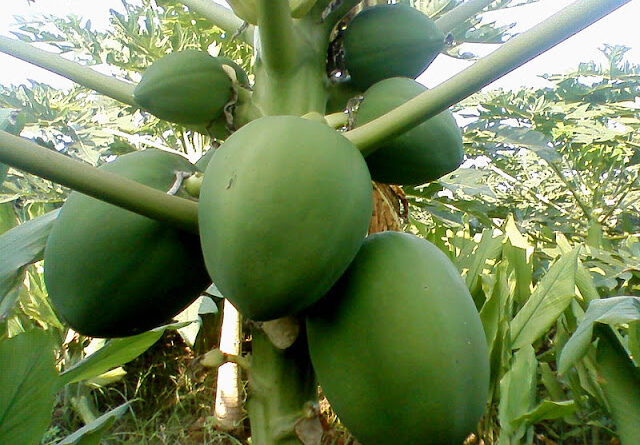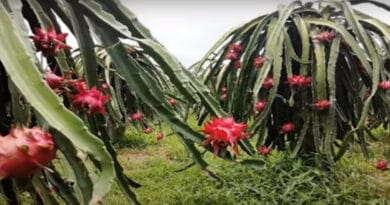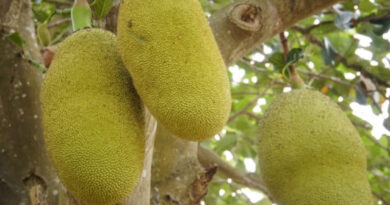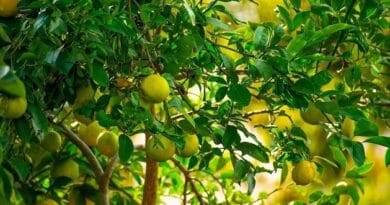Cultivation of Papaya ;Carica papaya L.
Papaya is a succulent fruit that belongs to the family Caricaceae of the tropical and sub-tropical regions of the country. Papaya crop is sensitive to waterlogged conditions and frost.
Papaya plants are dioecious, meaning that their male and female flowers grow on different plants. Their fruit production is heavily reliant on insect pollination. Certain papaya varieties are hermaphrodites, meaning that they may self-pollinate and produce both male and female flowers on the same plant. Commercial production of these hermaphrodite papaya varieties is more common
It is ranked the fifth most important fruit crop of India .It is believed to be grown in about 97,000 hectares of land with an average production of 5,3 million metric tonnes (2023) in various states in India like Bihar, Assam, Gujarat, Maharashtra, Tamil Nadu, Andhra Pradesh, Rajasthan, U.P., Karnataka, Chhattisgarh, and Odisha.
Nutritive Value of Papaya ;
| Serving Size 100 g | %DV | |
| Callories | 52 kcal | |
| Total Carbohydrate | 14 g | 4% |
| Dietary Fiber | 2.4 g | 9.00% |
| Sugar | 10 g | |
| Protein | 0.3 g | 0% |
| Choclestrol | 0 | 0% |
| Saturated fat | 0 | 0% |
| Sodium | 1 mg | 0% |
| Potassium | 107 mg | 3% |
| Iron | 0% | |
| Calcium | 0% | |
| Magnacium | 1% | |
| Vitamin C | 7% | |
| Vitamin B6 | 0% | |
| Vitamin D | 0% | |
| Cobalamin | 0% | |
| *Percent Daily Values are based on a 2,000 calorie diet. Your daily values may be higher or lower depending on your calorie needs. Source; USDA | ||
Benefits of Papaya Fruit ;
Besides, the ripe fruit is very refreshing, high in nutritive values, and is prized for its medicinal properties. Papain, a protein-digestible enzyme, is found in the white latex mainly from the immature fruits. It is said to be beneficial for ulcer, diphtheria, and even cancer treatments, besides being used for clarification of beer, the tanning industry, and the manufacture of chewing gum.
Papaya fruit is a good source of folate, Vitamin A, Vitamin B, Vitamin C, magnesium, copper, pantothenic acid, and fibre.
Agro-Climatic Conditions Requirements for Papaya Cultivation ;
It can grow under dry conditions and tolerate extremes of temperature except frost. However, it grows and fruits well in summer temperatures ranging from 37 to 43°C and winter temperatures not below 12 – 14°C. The low temperatures and frost are limiting factors of its cultivation in North India.
Even though the tree is adapted to a wide range of soils, it grows best in loamy soils. It does not tolerate water standing around the trunks, nor will its roots live in waterlogged soils.
Soils with a pH of 5.5 to 7 are suitable for papaya cultivation. Under the high humidity and low-temperature conditions, the fruit of papaya loses its sweetness. A warm and dry condition is required for the ripening of the Papaya fruit
Selection of Papaya varieties ;
Due to uncontrolled pollination and sexual multiplication, the varieties do not remain pure and give rise to variations both in tree and fruit characteristics. Some of the commercially grown varieties are –
State | Varieties |
Andhra Pradesh | Honey Dew, Coorg Honey Dew, Washington, Solo, Co-1, Co-2, Co-3, Sunrise Solo, Taiwan, Arka Surya, Arka Prabhanath |
Jharkhand & Bihar | Ranchi selection, Honey Dew, Pusa Delicious, Pusa Nanha, Pusa Majesty, Pusa Giant |
Karnataka & Kerala | Coorg Honey Dew, Coorg Green, Pusa Delicious, Pusa Nanha, Sunrise Solo, CO -3, CO-4 , Arka Surya |
West Bengal | Ranchi selection, Honey Dew, Washington, Coorg Green |
Orissa & CG | Pusa Delicious, Pusa Nanha, Ranchi selection, Honey Dew, Washington, Coorg Green |
Papaya Propagation;
Papaya Planting ;
Sex variation in Papaya ;
The papaya plant is normally unisexual. The plant bears male, female, and hermaphrodite (with male and female flowers on the same tree) and some other complex forms separately. Male flowers hang in long peduncles and are much smaller than female. The rudimentary pistils function in rare cases, leading to the development of small fruits of very little value. Thus, male trees are sometimes seen bearing small fruits.
Manuring in Papaya Crop;
The shoot growth and flowering are simultaneous in papaya. Therefore, plants must be kept growing vigorously to maintain a continuous supply of fruits. Thus, it is important to provide sufficient fertilizers in split doses.
A fertilizer trial from IIHR, Bangalore suggested the use 250 g N, 250g P, and 500 g K per plant for heavy yield. These doses should be applied in six split doses, at every two months intervals. Apart from this, 20-25 kg of F.Y.M. should be added to each tree per year.
Thinning in Papaya Crop ;
It is an important operation for the removal of undesirable fruits to obtain a better quality of fruits. Fruits should be removed when they are about 3 cm long. The extent of thinning should be such that the fruits do not touch one another when they mature. Excess thinning lowers the yield.
Diseases of Papaya crops;
Foot Rot of Papaya (Pythium aphanidermatum ) ;
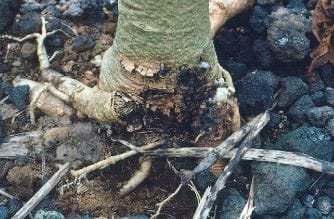
Footrot of papaya can be observed as water-soaked patches on the stem near the Ground Surface. These patches grow very rapidly and subsequently girdle the stem, which causes the rotting of the tissues. Such a type of plant can withstand strong winds and topple over and die. Under the mild attack of this disease, only one side of the stem rots, and the plants remain stunted. Though fruit is not formed, even if formed, they are shrivelled and malformed in shape and size. Gradually, the papaya plant dies under the influence of this disease.
Control: Apply Trichoderma viride 15 gm /plant around the root zone. Circular irrigation should be given, and drench the soil with copper oxychloride @ 2-3 gm /lit of water at a 15-day interval
Anthracnose of Papaya Plant: Colletotrichum gloeosporioides ;
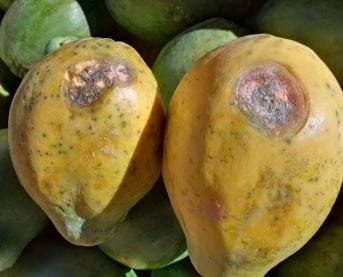
Papaya anthracnose disease commonly appears on green immature fruits. Symptoms of this disease are apparent in the form of brown to black depressed spots on the fruits. The basic symptoms are water-soaked, Brown sunken spots on the fruit surface of the papaya plant. which later on enlarges to form a water-soaked lesion on the fruit surface.
Control: Apply a Spray of Copper Oxychloride (3 g/litre of water) /Carbendazim (1 g/litre of water) / Thiophanate Methyl (1 g/litre of water) at 15-day interval effectively controls the disease. Fruits for exports should be subjected to hot water treatment or fungicidal wax treatment.
Powdery Mildew (Odium Indicum, Odium caricae) :
High humidity (80-85%) and a temperature range of 24-26°C are the favourable conditions for Powdery mildew in the Papaya plant. Its symptoms can be visualized on the foliage and pods in the form of white spots, which later on enlarge and cover the entire leaf area. The severely infected leaves may become chlorotic and distorted before falling. The size of the affected fruit became small and malformed.
Control: As the disease symptoms are visualized, the dusting of Sulphur @30 g/10 litres of water / spraying Calixin 75 EC @5 ml/10 litres of water at 15 days interval helps to control the disease.
Leaf- Blight (Corynespora cassicola):
This is a severe disease of papaya leaves. It first appears as small, discoloured lesions, which are irregularly scattered on the leaves. Later on these spots become irregular in shape and increase in size, and appear brown to grey. A light yellow zone surrounds the spots. Many lesions coalesce to cover large areas of the papaya leaf, and in severe infections, the whole leaf of the papaya plant dies. It causes a considerable reduction in the papaya yield.
Control: a spray of Dithane M-45 (0.2%) as soon as the symptoms appear
Papaya Mosaic:
Papaya mosaic may occur in all age groups, but it is more serious on young plants. This disease is transmitted by the Aphids. Symptoms appear on the top younger leaves of the papaya plants. The size of leaves was reduced and showed blister-like patches of dark-green tissue, with an alternating yellowish-green lamina. The fruits are borne due to this disease, plants develop a water-soaked lesion with a solid spot in the centre. The shape of such fruits is becoming elongated and reduced in size.
Control: Removal and destruction of the affected plant reduce the chance of disease spread. By controlling the population of aphids, the losses in yield may be recovered. Spraying of Carbofuran (1 kg a.i./ha) at the time of seeds sowing 2-3 foliar sprays of Phosphamidon (0.05%) at an interval of 10 days starting from 15-20 days after sowing can effectively check the population of aphids.
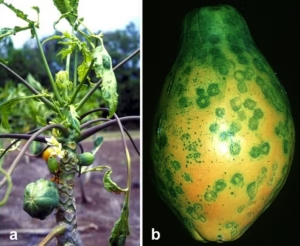
Papaya Ring Spot Virus: This viral disease is spread from plant to plant by aphids. The early visible symptoms on papaya are yellowing and vein-clearing of the young leaves. Subsequently, a very conspicuous yellow mottling of the leaves occurs and sometimes severe blistering and leaf distortion can also occur. Dark-greeny streaks and rings can also be seen in the leafstalks and stems of the papaya plant. Vigour of trees and fruit set is usually stunted depending on the age of the plant when infected. The quality of the fruit
( flavour ) is also adversely affected.
Control: Early detection and prompt removal of infected plants can stop the spread of the disease. Spraying of Carbofuran (1 kg a.i./ha) in the nursery bed at the time of sowing of the papaya seeds and 2-3 foliar sprays of Phosphamidon (0.05%) at an interval of 10 days, starting from 15-20 days after sowing, can control the Aphid populations
Pest of Papaya Plants;
Papaya mealybug (Paracoccus marginatus) ;
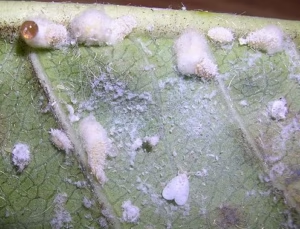
Mealybugs have a wide host range, which is often tended by ants that farm them for their sugary honeydew secretions. Flattened oval to round disc-like insect covered in cottony substances found the on papaya plant which causes chlorosis, stunted plant growth and leaf deformation, Due to the early leaf and fruit drop insects attract ants Due to which insect colony is formed which may also be associated with the growth of sooty mold due to fungal colonisation of sugary honeydew excreted by the insect.
Control: Mealybugs can be controlled by their natural enemies, such as lady beetles, but are most commonly controlled using chemicals.
Spraying of neem oil (1 to 2%) or Fish Oil Rosin Soap (25 g/litre of water) or by the use of chemicals like profenophos 50 EC, chlorpyriphos 20 EC, buprofezin 25 EC, thiomethoxam 25 WG, and imidacloprid 17.8 SL.
Scale insects (White peach scale);

Mating of adult scale insects retains their eggs inside the body until they hatch.
Scale insects damage plants by continuously feeding on the branches and fruit and injecting toxins into the plant.
Under the heavy infestation, gumming may occur on the bark and twigs or entire branches can be damaged; insects are flattened discs, or “scales” with no visible legs; scale insects produce a white waxy coating which later on turns black.
Control: Papaya plant can be sprayed with certain horticultural oils, which effectively kill scales without affecting the natural enemies.
Harvesting and yield;
Papaya plants start flowering about 5-6 months after transplanting and take another five months for harvesting. Except during hot, scorching summers and extreme winters, the plants continue to flower and fruit throughout the year. Fruits are harvested when they become firm and the latex is no longer milky but watery. Change of colour of fruits from dark green to yellowish is another parameter for the harvesting stage. Economic bearing in Papaya used to be up to three years. About 30 to 35 kg of fruit/tree may be obtained annually.
Read Further;
Cultivation of Banana ;Musa paradisiaca L
Cultivation of Lime and Lemon (Kagzi ) for Good Income Returns
